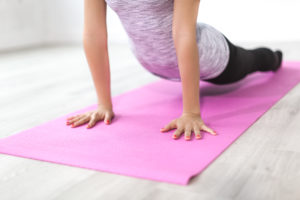After an injury or a surgery, you might feel like all the fitness gains you’ve made were for naught, like you’re back at square one. This can be frustrating and even depressing, but it’s important to know that you can get back to being active again as long as you do so safely. Here’s how to start working out again after spending some time on the bench:

Ask Your Doctor
This is step number one. Even if you think you should be able to go back to working out, always get your doctor’s OK first. You may have had to stay almost motionless during the first stages of your recovery, but the chances are that even if your doctor doesn’t think you’re ready to hit the gym, you can probably get off the couch. Ask your doctor about stretches or other gentle activities you can do to prepare your muscles for a work out once you can go back. Stretching and walking can ease the stiffness from your time in bed and help you test out your limits safely. If your doctor says you can resume normal activities, then follow the steps below.

Start Small
It might be tempting to go back to running your 5-K or doing your hour-long full-body circuit at the gym, but it’s not a good idea. The last thing you want to do is aggravate your injury and earn yourself more time sitting around the house. You probably will be able to get back to your pre-injury level, but you can’t start there. A good rule is to do 50% of what you did before your injury.
If you used to run 5 miles, try walking 2 miles and then gradually lengthen your distance, working up to a jog, then to running. Be prepared to spend several weeks, possibly a few months, working your way back up. Mild discomfort as you get back to your workout is acceptable, but any pain beyond that is a sign to stop immediately. Pain that lasts an hour or more after your workout ends is a sign you’ve pushed yourself too far. Take a couple of days off and then do a less strenuous routine.

Cross Train
You probably did this before your injury, but cross-training is a great way to get active again after an injury too. An injury to your ankle might prevent you from running or doing leg day, but you could still do an upper-body routine. The same goes for an injury to the upper body; try to get in leg workouts, walks, etc. This will allow you to be active without aggravating the injured area.
Consider adding gentle exercises like tai chi or yoga into your routine. These can help with healing by lowering stress levels, increasing circulation, and building flexibility. Keep in mind that not all yoga routines are gentle; ask a trained yoga instructor about routines for your specific needs.

Get in the Water
As long as you don’t have an open wound, water can be a wonderful way to exercise during recovery. The buoyancy will take the pressure off your joints and tissues, allowing you to be active with less strain. Ask your doctor what sorts of water exercises would be appropriate for you and then try them out at your local pool.

Look into Healing Therapies
Talk to your chiropractor about how to speed your body’s healing process. Techniques like laser therapy and acoustic compression therapy can be used on many types of injuries. These therapies increase circulation, decrease inflammation, and can help to discourage the formation of excess scar tissue or break up old scar tissue. A healthy heal is important for anyone who wants to remain active after an injury. Excess inflammation or scar tissue can cause stiffness and decrease your ability to exercise.

Hot- Cold Therapy
For some types of injuries, hot, cold therapy can help reduce pain and stiffness. Ask your doctor how to do this at home. You may find it helpful before or after your workouts to aid in recovery. If you are using water to help you get active again, consider a dip in the hot tub before you swim to warm up your muscles. Injured areas that get inflamed after activity might benefit from cold therapy.

Focus on Nutrition
What you eat can aid your healing process, just like a protein shake aids with muscle recovery after a workout. Talk to your doctor or nutritionist about your dietary needs. They might recommend supplementing certain nutrients to help with your recovery. You may also need more calories after you begin working out again to keep up with the demands of your healing body and your new activity level. While you are less active than usual, you may need to restrict your calories to avoid gaining weight. Since healing from an injury can change your calorie requirements, it’s important to run any dietary changes by a professional.

Get into the Right Head-space
Your off-time while healing is a good time to think about how to avoid future injuries. It’s possible that you didn’t do anything wrong or that your injury is not a result of athletic activity, but if you did get hurt in the gym or on the field, now’s the time to learn a lesson. Did you push yourself too hard? Use equipment inappropriately? Not wear the right protective gear? If any of these sounds right, make sure you don’t repeat the mistake as you get back to being active. You may benefit from consulting a trainer who can help you keep the right form during exercise, or you may need to be more patient with yourself and not push so hard.
Regardless of how you got injured, your recovery can help teach you to listen to your body. Remember that while pushing past mild pain can help you get to the next level, serious pain is a sign you need to take a step back. Your body may not be on board with your workout plan. If you’re having a day where you feel weak or just can’t push yourself, it’s OK. Those situations are an opportunity to reevaluate what you are doing and see if you need to tweak something. Meeting your goals a bit more slowly is better than having to sit out for months.





